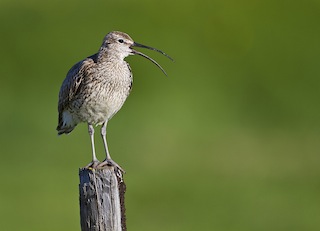 Whimbrels may be spotted at Lizard Point on migration in the spring and later summer into autumn.
Whimbrels may be spotted at Lizard Point on migration in the spring and later summer into autumn.
Photo: © Natural England/Allan Drewitt
Scientific name: Numenius phaeopus
Conservation status: UK Birds of Conservation Concern, Red; IUCN Red List, Least Concern
What to look for:
- Colouring and appearance: Grey-brown above, paler below, dark eye-stripe, with long legs and a long bill curved at the tip.
- Size: Length 37 to 45 cm, wingspan 78 to 88 cm.
- Where: Passage migrant in spring and autumn; summer breeding colonies in northern Scotland, including Orkney and Shetland.
- Call: Repeated notes
- Similar species: Curlew, Bar-tailed Godwit
 There is a legend of the Seven Whistlers, human souls in the guise of six birds that fly through the skies looking for a lost seventh bird. Their eerie cries warn of impending disasters and tragedy. If you’ve listened to the call of a Whimbrel, it’s no surprise that this is one of the species associated with this legend.
There is a legend of the Seven Whistlers, human souls in the guise of six birds that fly through the skies looking for a lost seventh bird. Their eerie cries warn of impending disasters and tragedy. If you’ve listened to the call of a Whimbrel, it’s no surprise that this is one of the species associated with this legend.
In the UK, Whimbrels only breed in northern Scotland, but can be spotted round the coast in April and May, and then again in July and August, as they migrate from and to their wintering home in the south of Africa. On migration they are primarily a coastal species, using their long bills to search for invertebrates, small crabs in particular, in the sand and mud of estuaries. Although they migrate in flocks, they are usually spotted feeding alone or in a spread-out group, each individual maintaining a territory to protect its food sources. At other times of year they will also eat insects, with berries and seeds also important at the end of summer when insect populations are declining.
The Whimbrel has a red status in the UK due to concerns over declines in the breeding population. Some 500 pairs breed here in the far north, including on Orkney, Shetland and the Hebrides, where the population seems to have more recently stabilised.
Did you know…?
…The oldest recorded Whimbrel had reached a grand old age of more than 24 years. They more usually live for around ten years.
More information and references:
Svensson, L., Mullarney, K., Zetterstrom, D.,1986. Collins Bird Guide, second edition (translated by Christie, D., Svensson, L.). HarperCollins, London.
Published: August 2015
Author: Amanda Scott
Photos: © Natural England/Allan Drewitt
